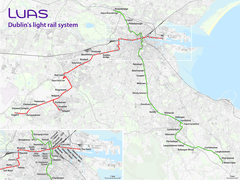Luas
Luas (Irish pronunciation: [ˈl̪ˠuəsˠ]; Irish for "speed") is a tram/light rail system in Dublin, Ireland. There are two main lines: the Green Line, which began operating on 30 June 2004, and the Red Line which opened on 26 September 2004. Since then, both lines have been extended and split into different branches further out of the city. The two lines, as of 2017, now intersect and connect within Dublin city centre. The system now has sixty-seven stations and 42.5 kilometres (26.4 mi) of revenue track,[1] which in 2018 carried 41.8 million passengers,[3] an increase of 11.2% compared to 2017.[1][4]
 Luas logo | |||
_(1507653387).jpg) Luas tram in Dublin City Centre | |||
| Overview | |||
|---|---|---|---|
| Locale | Dublin | ||
| Transit type | Tram (or Light rail) | ||
| Number of lines | 2 (Red and Green) | ||
| Number of stations | 67 | ||
| Daily ridership | 114,500 passengers[1] | ||
| Annual ridership | 48 million passengers [2](2019) | ||
| Operation | |||
| Began operation | 30 June 2004 | ||
| Operator(s) | Transdev | ||
| Number of vehicles | 26 Citadis 301 (3000 Class) 14 Citadis 401 (4000 Class) 34 Citadis 402 (5000 Class) | ||
| Technical | |||
| System length | 42.1 kilometres (26.2 mi)[1] | ||
| Track gauge | 1,435 mm (4 ft 8 1⁄2 in) (standard gauge) | ||
| Electrification | 750 V DC overhead line | ||
| |||
Luas is operated by Transdev, under tender from Transport Infrastructure Ireland (TII). (Prior to the later RPA merger with the National Roads Authority to form TII, the tender was originally under the defunct Railway Procurement Agency jurisdiction). The Luas was a major part of the National Transport Authority's strategy (2000–2016).[5] Three extensions to the existing Luas lines have been completed. Construction of a 6 kilometres (3.7 mi) extension to the Green line to the North city centre and Broombridge, which links both Green and Red lines, began in June 2013 and opened to passengers in December 2017. This is the extension route previously known officially as BXD.[6]
History
The idea for a new tram or light rail system for the city of Dublin was first suggested in 1981, by a Dublin Transportation Initiative (DTI) report,[7] which referenced the original Dublin tramways, once running over 60 kilometres (37 mi) and reaching most parts of the city. Following this report Córas Iompair Éireann (CIÉ), the state-owned public transport operator in Ireland, was asked to study the different options. They recommended two phases for the construction of a tram system:
- Phase 1: Tallaght to Dundrum/Balally via the City Centre
- Phase 2: Ballymun to the City Centre and Dundrum/Balally to Sandyford.
The Transport Act, 1996 created a legal framework for CIÉ to build a tram system and in May 1997 the company applied for a Light Railway Order to construct the first phase, as well as the Dundrum/Balally to Sandyford part of phase 2.
An inquiry started in July 1997, but was put on hold to investigate the possibility of underground sections in the city centre. In May 1998 the government decided to build two lines, amending the plans. The first was to run from Tallaght to Connolly Station, while the second would run from Sandyford Industrial Estate to Dublin Airport, through the city centre and Ballymun. Part of the second was to be underground through the city centre.
The responsibility for developing Luas was transferred from CIÉ to the Railway Procurement Agency (RPA), a separate government agency created in December 2001.[7]
Construction work began in March 2001 on the Tallaght to Connolly line, as well as the Sandyford to St. Stephen's Green section of the second line, with Ansaldo of Italy and MVM of Australia getting the contract to build the system.[8] The St. Stephen's Green to Dublin Airport section was dropped before construction began, as it was decided to serve the area by a metro instead. The contract to maintain and operate the system was awarded to Connex.[9][10][11]
The development of Luas Red Line was facilitated by European Union funding of €82.5 million under the European Regional Development Fund,[11] and part of the cost of some line extensions (e.g. over 50% of Line B1 to Cherrywood) was raised though levies on development in areas close to the projected route.[12]
Launch
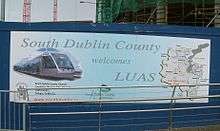
The original launch date for Luas was to be 2003, but delays in construction saw this date pushed back by a year. An advertising campaign took place to inform the public of the development of the system, while construction was taking place. Construction finished in February 2004 and a period of testing and driver training began. 30 June 2004 was decided on as the official launch date of the Green Line.[13] The first tram went into service for the general public at 3 p.m. Several days of free travel and a family fun weekend took place to launch the system. The Red Line opened on 26 September 2004, with six days of free travel for the general public.[7]
2004 to present
By November 2006, over 50 million journeys had been made on the system.[14] Around 90,000 Luas trips are made each day. 28.4 million journeys were made in 2007. 27.4 million journeys were made in 2008.[15] 25.4 million journeys were made in 2009.[16] To date, the busiest day on Luas was Friday, 21 December 2007 when 145,000 passenger journeys were recorded.
Luas operates without a state subvention. The service recorded a surplus of €985,000 (€680,000 in 2004) – an achievement well ahead of an anticipated deficit of €2.5 million.[17]
On Tuesday, 8 December 2009 the Red Line C1 Connolly to Docklands extension opened.[18] There are four stops: George's Dock, Mayor Square-NCI, Spencer Dock (serving the new Docklands railway station, approximately 350 metres (1,150 ft) away) and terminating in Point Village, opposite the 3Arena, this extension however bypasses Connolly. Construction started at the beginning of June 2007.[19] Test runs began on the line in September 2009 before the opening.[20]
On, 16 October 2010 the B1 extension from Sandyford to Cherrywood opened.
Luas Cross City
In June 2010, plans to join the two Luas tracks were finalised.[21] On 20 May 2011 Dublin City Council made submissions to An Bord Pleanála's Oral Hearing into Line BXD stating that the Planning Authority had a serious area of concern with the overhead conductor system in the historical city centre asking for a wire-free zone.[22][23]
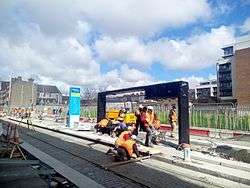
Luas Cross City is an extension of the Green Line which links with the Red Line, and continues northwards to Broombridge in North Dublin (interchange with Iarnród Éireann station). The extension began at the existing St Stephen's Green Green Line stop. Construction started in June 2013, with services beginning in December 2017.[24]
- Line BX (includes Line D to Broombridge) – City Centre link for Red and Green Lines. The RPA started public consultation on the route in December 2005. In March 2007 the preferred route was announced.[25] The route runs from St Stephen's Green to College Green where the line changes from a double track to single track. From here it runs north through Westmoreland Street, over O'Connell Bridge and along the west side of O'Connell Street to Cathal Brugha Street. It then turns east into Cathal Brugha Street and turns south to run along Marlborough Street, across the River Liffey on the Rosie Hackett Bridge, continues along Hawkins Street and College Street and joins up with the double-track section of the line at College Green. 2012 was the original completion date given in the Transport 21 plans, but construction only started in 2013. The completion date, along with the commencement of passenger services, was December 2017. The RPA applied for a Railway Order application to An Bord Pleanála for a combined Line D / Line BX Luas Line that runs from St Stephen's Green to Broombridge via the city centre and Broadstone / Grangegorman.[26]
- Line D – City Centre to Liffey Junction. This serves Grangegorman, the site of the proposed new Dublin Institute of Technology campus. This line is linked with the Maynooth line.
On 10 November 2011, the government announced in its 2012–16 Infrastructure and Capital Investment plan that the project to link the Red and Green lines, known as BXD, was to proceed. No other new lines or extensions were being funded.[27][28] Construction work for the new Rosie Hackett bridge across the River Liffey (connecting Marlborough St and Hawkins St) began in April 2012, on which the southbound Luas BXD track was laid.[29] A Railway Order was granted by An Bord Pleanála for Luas BXD line on 3 August 2012. The project was subsequently branded as Luas Cross City.[30] Cross City opened to passengers on 9 December 2017.[31][32]
Infrastructure
Luas Red Line | ||||||||||||||||||||||||||||||||||||||||||||||||||||||||||||||||||||||||||||||||||||||||||||||||||||||||||||||||||||||||||||||||||||||||||||||||||||||||||||||||||||||||||||||||||||||||||||||||||||||||||||||||||||||||||||||||||||||||||||||||||||||||||||||||||||||||||||||||||||||||||||||||||||||
|---|---|---|---|---|---|---|---|---|---|---|---|---|---|---|---|---|---|---|---|---|---|---|---|---|---|---|---|---|---|---|---|---|---|---|---|---|---|---|---|---|---|---|---|---|---|---|---|---|---|---|---|---|---|---|---|---|---|---|---|---|---|---|---|---|---|---|---|---|---|---|---|---|---|---|---|---|---|---|---|---|---|---|---|---|---|---|---|---|---|---|---|---|---|---|---|---|---|---|---|---|---|---|---|---|---|---|---|---|---|---|---|---|---|---|---|---|---|---|---|---|---|---|---|---|---|---|---|---|---|---|---|---|---|---|---|---|---|---|---|---|---|---|---|---|---|---|---|---|---|---|---|---|---|---|---|---|---|---|---|---|---|---|---|---|---|---|---|---|---|---|---|---|---|---|---|---|---|---|---|---|---|---|---|---|---|---|---|---|---|---|---|---|---|---|---|---|---|---|---|---|---|---|---|---|---|---|---|---|---|---|---|---|---|---|---|---|---|---|---|---|---|---|---|---|---|---|---|---|---|---|---|---|---|---|---|---|---|---|---|---|---|---|---|---|---|---|---|---|---|---|---|---|---|---|---|---|---|---|---|---|---|---|---|---|---|---|---|---|---|---|---|---|---|---|---|---|---|---|---|---|---|---|---|---|---|---|---|---|---|---|---|---|---|---|
| ||||||||||||||||||||||||||||||||||||||||||||||||||||||||||||||||||||||||||||||||||||||||||||||||||||||||||||||||||||||||||||||||||||||||||||||||||||||||||||||||||||||||||||||||||||||||||||||||||||||||||||||||||||||||||||||||||||||||||||||||||||||||||||||||||||||||||||||||||||||||||||||||||||||
Luas Green Line | ||||||||||||||||||||||||||||||||||||||||||||||||||||||||||||||||||||||||||||||||||||||||||||||||||||||||||||||||||||||||||||||||||||||||||||||||||||||||||||||||||||||||||||||||||||||||||||||||||||||||||||||||||||||||||||||||||||||||||||||||||||||||||||||||||||||||||||||||||||||||||||||||||||||||||||||||||||||||||||||||||||||||||||||||||||||||||||||||||||||||||||
|---|---|---|---|---|---|---|---|---|---|---|---|---|---|---|---|---|---|---|---|---|---|---|---|---|---|---|---|---|---|---|---|---|---|---|---|---|---|---|---|---|---|---|---|---|---|---|---|---|---|---|---|---|---|---|---|---|---|---|---|---|---|---|---|---|---|---|---|---|---|---|---|---|---|---|---|---|---|---|---|---|---|---|---|---|---|---|---|---|---|---|---|---|---|---|---|---|---|---|---|---|---|---|---|---|---|---|---|---|---|---|---|---|---|---|---|---|---|---|---|---|---|---|---|---|---|---|---|---|---|---|---|---|---|---|---|---|---|---|---|---|---|---|---|---|---|---|---|---|---|---|---|---|---|---|---|---|---|---|---|---|---|---|---|---|---|---|---|---|---|---|---|---|---|---|---|---|---|---|---|---|---|---|---|---|---|---|---|---|---|---|---|---|---|---|---|---|---|---|---|---|---|---|---|---|---|---|---|---|---|---|---|---|---|---|---|---|---|---|---|---|---|---|---|---|---|---|---|---|---|---|---|---|---|---|---|---|---|---|---|---|---|---|---|---|---|---|---|---|---|---|---|---|---|---|---|---|---|---|---|---|---|---|---|---|---|---|---|---|---|---|---|---|---|---|---|---|---|---|---|---|---|---|---|---|---|---|---|---|---|---|---|---|---|---|---|---|---|---|---|---|---|---|---|---|---|---|---|---|---|---|---|---|---|---|---|---|---|---|---|---|---|---|---|---|---|---|---|---|---|---|---|---|---|---|---|---|---|---|---|---|---|---|---|---|---|---|---|---|---|---|---|---|---|---|---|---|---|---|---|---|---|---|---|---|
| ||||||||||||||||||||||||||||||||||||||||||||||||||||||||||||||||||||||||||||||||||||||||||||||||||||||||||||||||||||||||||||||||||||||||||||||||||||||||||||||||||||||||||||||||||||||||||||||||||||||||||||||||||||||||||||||||||||||||||||||||||||||||||||||||||||||||||||||||||||||||||||||||||||||||||||||||||||||||||||||||||||||||||||||||||||||||||||||||||||||||||||
Stations and lines
The network currently comprises two lines:
- Red Line – The Point or Connolly station to Saggart or Tallaght (each route is approximately 20.7 kilometres (12.9 mi) long, but the total track length is longer since the Belgard-Tallaght and Belgard-Saggart sections are separate parts of the Red Line)
- Green Line – Broombridge via Sandyford to Bride's Glen, 24.5 kilometres (15.2 mi)
The Red Line runs east-west through Dublin's Northside, then crosses the River Liffey and travels southwest to the heavily populated suburb of Tallaght, and then on through the Citywest campus to terminate at Saggart. It was planned, designed and constructed in two separate stages:
- Line A: Tallaght to O'Connell Street
- Line C: O'Connell Street to Connolly Station
This was followed by two extensions:
- Line C1 from Connolly to The Point, which opened in December 2009
- Line A1, the spur from Belgard to Saggart, which opened in July 2011
On the south side of Dublin city, the Green Line mostly follows the route of the old Harcourt Street railway line, which was reserved for possible reuse when it closed in 1958. It was known internally as Line B during planning and construction, and has also had several extensions:
- Line B was originally from Sandyford to St Stephen's Green.
- Line B1 is the extension from Sandyford to Bride's Glen which opened in July 2010.
- Line BX is the extension from St Stephen's Green to connect with the Red Line which opened in December 2017.
- Line D extends Line BX to Broombridge and opened simultaneously with Line BX in December 2017.
- Line B2 is a proposed extension from Bride's Glen to Bray.
The Red Line and Green Line have been connected to each other since 9 December 2017. There are 32 stops on the Red Line and 35 (plus two further unopened stations) on the Green Line.
A third line to Lucan (Line F) is planned. The line is planned to start in the city centre and travel north west to Lucan.
Track and rolling stock

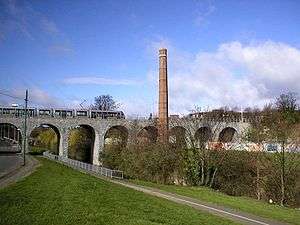
The system operates on a 750 V DC overhead power supply. The international standard rail gauge of 1,435 mm (4 ft 8 1⁄2 in) is used, rather than the Irish 1,600 mm (5 ft 3 in).[33]
The silver Alstom Citadis trams, manufactured in La Rochelle, France, reach a top speed of 70 km/h on off-street sections, but travel at a slower speed on-street where conflicts with other vehicles and pedestrians can occur. The 26 initial Red Line '3000' Class trams were 30-metre (98 ft) long Citadis 301 configurations with a capacity of 256. The 14 Green Line '4000 Class' trams, each 40-metre (130 ft) long Citadis 401 configurations, have a capacity of 358 including two wheelchairs.[33] Starting in 2007, all the Red line trams were upgraded to 40 metres (130 ft) by inserting two more articulated sections, with the last one converted by June 2008.[34] Both configurations of tramcars are fully compatible with both the Red and the Green Lines.
Twenty-six new 43-metre Citadis 402 trams, numbered as the '5000 Class', were ordered for delivery in early 2009. These are 100% low-floor configuration and solely operate on the Green Line, with the 4000 Class trams cascaded to the Red Line after the entire 5000 Class had been introduced.
Seven further, 55-metre (180 ft) Citadis 402 variants were procured for use on the St. Stephen's Green – Broombridge line. They were brought into service between January and June 2018.[35] These are numbered as members of the 5000 Class, with all existing 5000 Class units being lengthened to match.[36] 8 further new units were ordered for delivery during 2020, with the first of those entering service in July 2020.[37] In October 2019, it was announced that 26 existing Green Line trams would be extended to 55 metres (180 ft).[38]
In other aspects, the two lines are identical except that the inter-axis width between the tracks on the Green Line is slightly wider than on the Red Line. The construction planning for the Green Line ensures a distance of track centres at 3,400 millimetres (11.2 ft) including a 400 millimetres (16 in) extra for the kinematic envelope of metro trains.[39] This does not relate to the track gauge of 1,435 mm (4 ft 8 1⁄2 in), which is identical on both lines. This will allow wider metro trains be run on the same tracks if a proposed upgrade to full metro service is implemented.[40] This is possible because the route uses an old railway line and as such has few interactions with vehicular or pedestrian traffic. The Railway Procurement Agency has stated (November 2006) that "We still envisage conversion of almost all Luas lines to light metro standard in the long-term.".[12] Platform length also varies between lines, with the original 40-metre (130 ft) platforms lengthened to 55 metres (180 ft) on the Green Line [41]
The main engineering structures on the Green Line at present are Milltown Viaduct, also known as The Nine Arches, a large stone viaduct dating from 1854, and the William Dargan Bridge, a large cable-stayed bridge at Taney Cross, near Dundrum town centre.
Travel on Luas
Ticketing
Luas tickets are purple in colour and credit card sized. They bear a magnetic stripe on the back although this is not used on Luas. Uniquely among Dublin's public transport, tickets are not checked upon boarding trams; instead, a proof-of-payment system is used.
Ticket machines operate at every Luas stop and these are the only source of single-journey and return tickets. They also sell 1-day, 7-day and 30-day tickets, valid in either some or all the fare zones, for adults, children and students. It is also possible to purchase 'Combi' tickets valid on Dublin Bus and Luas. DART and Luas 'Combi' tickets have been produced since Luas opened but despite this being a major ticket option these Luas-DART Combis are not available at either ticket newsagents or online from either Iarnród Éireann or Luas, nor are they available in Luas vending machines. They are available only from Iarnród Éireann ticket offices. Transport user lobby groups like 'Rail Users Ireland' have written to both Luas and Iarnród Éireann asking for an explanation for this and none has been forthcoming. While it is also possible to purchase Luas-DART-Dublin Bus 'triple combi' tickets (from Iarnród Éireann booking offices) from monthly ramblers upward, these are often more expensive than simply topping up a Leap Card to its weekly cap rate (currently €40 for Adults). Certain ticket combinations are not possible (for example a one-day student ticket), and tickets can only be valid from the stop at which they are purchased and must commence their validity within 90 minutes, valid until a specific time shown on the card. Certain tickets require the user to hold an ID card and write the number on the ticket, to prevent the ticket from being transferred to another person. Ticket machines accept card payments (by American Express, Laser, MasterCard, or Visa and have a weekly limit of €150 (upper limit changed from €50 per transaction to €150 per week in January 2012 after upgrading all POS terminals to have a PIN keypad).[42] Formerly €5 was the minimum amount which could be paid via card, but this limit has since been removed.[43] Like other Irish transport operators, Luas has taken to requiring students to purchase a special Student Travelcard, not recognising their student cards as enough to get a discount. These have been merged with the Leap Cards to form a personalised orange Leap Card with new benefits such as lower daily caps.
Luas tickets are sold at newsagents and other shops, mostly in the vicinity of Luas stops. Joint Luas and Dublin Bus tickets can be purchased from Luas vending machines for immediate use, as well as from Dublin Bus ticket agents. Tickets bought at Dublin Bus agents must be validated on a bus before being valid for a tram (since Luas does not use ticket validation systems upon boarding the tram). Certain tickets are cheaper in shops than at ticket machines. Tickets cannot be purchased on board the trams.
Both lines are divided into 5 zones, the central zone being shared. Fares are calculated based on how many zones a journey is taken through. There is a stop on the border of each zone, which is considered to be in whichever zone is more beneficial to the traveller. It is necessary to walk between the two lines, most commonly between O'Connell Street-GPO (on the Green Line) and Abbey Street (on the Red Line). Alternatives include buses (the number 18 links Ranelagh to Kylemore, although these are not included on the ticket) and taxis.
Smartcard
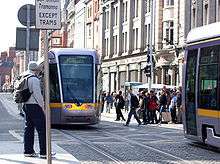
In March 2005, a smartcard for Luas was launched. The smartcard was phased out following launch of the integrated Leap Card which is further detailed below. The final day of Luas Smartcard operations was on 30 September 2014. The Luas smartcard allowed travellers to pay for travel on the Luas network. Credit was pre-loaded onto the smartcard at ticket machines by cash, debit card or credit card, with a minimum top-up of €5 and a maximum credit on the card of €100, and the customer had to validate the card using readers on the platform before boarding the tram and then again after exiting the tram. This is still referred to as 'tag-on' and 'tag-off' on the current Leap Card system.
A smartcard could be purchased at a Luas ticket agent or online.[44] The card cost €10, which included a €3 non-refundable charge for the card, €3 of credit and €4 for a fully refundable 'reserve fund' which allowed travel even if there was insufficient credit on the card for the journey. The card had to be topped up before another journey could be taken.
Smartcard fares were slightly cheaper than standard single and return fares from ticket machines. For example, a journey within a single zone cost €1.25 with the card, compared to €1.50 (€1.60 during peak time) single with a paper ticket, or €2.80 return. Daily, 7-day and 30-day tickets generally worked out cheaper, unless used only rarely. Luas smartcards were unable to store multiple-journey tickets and these tickets were issued on paper only until May 2014, since all tickets have been loaded onto the new Leap Cards.
Until January 2012 there were three different smart-card systems in Dublin: the Luas smart-card, the Dublin Bus prepaid Smartcard system for day-cards or longer[45] and the smart-card for commuter trains and the DART which is -as the Luas card- a per journey tag on/off card but not compatible with Luas cards.[46]
Over a number of years, the Railway Procurement Agency had been working on the design of an integrated ticketing system [47] and was many years behind schedule and is estimated to have cost €30m to complete.[48] This new card, marketed under the name Leap Card has been fully operational since January 2012 and allows the purchase of single journey tickets for Luas, DART, Commuter and Dublin Bus routes. The card carries a credit, which can be topped up, which is then used to pay fares. On Dublin Bus, passengers present the card to the driver's ticketing machine and ask for the appropriate ticket. On Luas, passengers "tag-on" before entering the tram and "tag off" at the destination; the correct fare is then deducted. The same applies to DART and Commuter trains, but there the tagging is normally done when passing the electronic entry/exit gates. (For stations without these gates, there are tag-on/off terminals at the platform).
The "Leap Card" smartcard has functionality that it caps the daily and weekly spend to ensure Leap Card holders do not pay more than they would have had they bought day, weekly, or monthly tickets. This functionality had been enabled on Luas and DART services. As of 2017, the National Transport Authority reported the number of Leap Card users was 2.5 million.[49]
Free travel
All persons in Ireland are entitled to be issued with a Public Services Card for accessing key public services and for identity purposes. Persons on the following Social Welfare payments are provided with a Public Services Card with yellow "FT" in the top right-hand corner, which functions as a smart card in the same way as a Leap Card, but allows free travel:
- Pension (senior citizens over 66)
- Disability Allowance (persons with a disabling medical condition lasting longer than a year approved by a general practitioner, a departmental medical officer or a departmental welfare officer)
- Carers Allowance
Contrary to popular belief, free travel Public Services Cards are not given to persons on Jobseekers or any other social welfare payments other than those listed above, and they do not come automatically with any particular medical condition.
In practice, on Luas, this scheme is extended to holders of pensioner travel passes from the United Kingdom too. Because countries such as Canada and the USA do not have a national pass system for seniors / disabled and only have local discounted transit tickets available to them, all such visitors to Ireland must pay full adult fare on buses, trams and trains regardless of their age or disability, and would thus be better off financially with a Leap Visitor Card set with the appropriate period per-loaded (24 hours, 3 days, 7 days).
The free travel system was created by Ministerial Order (not an Act of the Oireachtas as with many such schemes) by then Minister for Health, Charles J Haughey in the late 1960s and is considered a 'third rail' politically.
Hours of operation and frequency

Trams operate from 05:30 to 00:30 Monday to Friday. On Saturday services run from 06:30 to 00:30, while on Sundays it is only from 07:00 to 23:30. Public holidays are the same as Sundays, except trams run until 00:30. Services run at regular intervals, from every 4–5 minutes during peak times to every 15 minutes late at night.
During the Christmas season (from early December to the last weekend before Christmas), a night service runs on Luas during Friday and Saturday nights (as well as on New Year's Eve), with the last trams departing the city centre at 03:30. However, fares are priced at a premium of €5 single (€4 on Leap Cards).
Accessibility
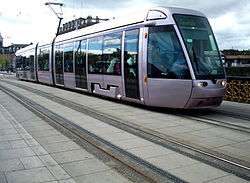
The low floors and wide spaces of the Citadis trams mean that wheelchair users can easily board. All stations have also been designed with ramps, to allow easy access. Several have lifts, such as Kilmacud and Dundrum on the Green Line, while Connolly Station has escalators that connect the Luas station to the main station building. The website for Luas also has an accessibility newsletter.
Safety

Before Luas was launched, a Safety Awareness Day was held in Dublin city centre. Thousands of reflective armbands were distributed to pedestrians and cyclists, in order to ensure their visibility for tram drivers. This policy seems to have worked as Luas has been described as being "one of the safest transport systems in the world".[50] Both trams and stops are monitored using CCTV 24 hours a day from the central control room, located in the Red Cow Depot.[51]
Before Luas was launched, it was feared that the tram system would lead to a high number of fatal accidents. So far, however, there have been only four fatalities. There have been many occurrences of cars striking trams, mainly caused by motorists breaking red lights. On 16 September 2009, a Luas collided with a Dublin Bus at the O'Connell Street-Abbey Street Junction. In the collision, 22 people were injured, three of them seriously, including the tram driver. Early investigations suggested that the bus had the green light to move, and that the Luas must have had technical problems.[52] The Luas driver was later charged with dangerous driving, causing harm and operating a tram in a manner which posed risk to others. He was subsequently acquitted of dangerous conduct by the Dublin Circuit Criminal Court.[53]
Security
Security on Luas trams, platforms and facilities is provided by STT Rail Security, a division of STT Risk Management.[54][55] STT employees patrol the system to counter anti-social or other incidents,[56] and sometimes intervene in incidents prior to the arrival of the Gardaí. Security officers are not armed, but wear tactical uniforms and stab-resistant body vests.[57]
Altercations with commuters
On 26 September 2019, Luas security grabbed a passenger by the neck and threw him to the ground, breaking a bone in his hand.[58] He was then pinned by two security guards for several minutes, despite repeatedly telling them that he could not breathe.[58] The incident is being investigated by the Gardai.[58]
The following day, on 27 September, an unidentified minor was tackled to the ground and restrained by two Luas security guards.[59] Transdev later confirmed that the incident was being investigated, but declined to comment further.[59]
Issues
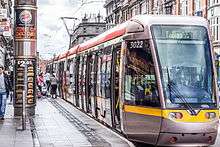
The cost of building the original Red and Green Lines was €728m. It was envisaged in the original plans that the Green Line would meet the Red Line at O'Connell Street. However, two separate unconnected lines were built, leaving a 1.1 km (10–15 minute walk) – through O'Connell Street, Westmoreland Street, College Green and Grafton Street – between the two lines. Plans to link the lines were announced with the proposed building of the BX Line under Transport 21: this was opened to passengers on 9 December 2017.[24]
Park and ride charges have also attracted criticism. The cost of parking for a full day is €4. It was described by former government Teachta Dála and head of the Dáil transport Committee Eoin Ryan as "unacceptable for Luas to charge passengers for parking at their Park and Ride facilities on top of ticket fares".[60] On 8 February 2018 there were traffic delays in south Dublin because the longer 55m Luas was too long for the bridge.[61]
Notable incidents
There have been several incidents involving Luas, often leading to its temporary closure. As of December 2019, this included ten fatal incidents, with approximately 480 million passengers carried.[62]
At 19:40 on 23 February 2008, A 59-year-old man was struck by a Red Line tram at Cookstown Way in Tallaght, and sustained serious head injuries. He died in hospital the following day.[63][64]
On 15 May 2009, a worker died at Citywest during the construction the Luas A1 extension to Saggart.[65]
At 15:00 on 16 September 2009 a Red Line Luas tram and a double-decker number 16 Dublin Bus collided at the crossroads of Abbey Street and O'Connell Street in Dublin city centre.[66] The front section of the tram was derailed in the incident and the driver's cabin was crushed flat against the left hand side of the bus.[67] At least 21 people were injured and three were seriously hurt, including the driver of the tram who had to be cut out from the wreckage.[68][69]
At 16:20 on 11 October 2011, a 35-year-old man, who was a Polish national, was struck and killed by a Red Line tram on Steevens Lane near Heuston Station.[70] Luas was stopped between the Heuston and The Point stops for 3 hours, trams between Tallaght and Blackhorse remained running throughout this period. Trams began running between Heuston and The Point again at 19:20.
On 28 June 2012, a 32-year-old woman was struck by a Luas tram in Inchicore, after falling onto the tracks at Blackhorse platform as a tram pulled in. She was caught between the platform and tram, and suffered severe head and body trauma. Emergency services managed to free her from under the tram, and the area was cordoned off for a forensic examination. She was rushed to hospital, and died of her injuries on 6 July 2012.[71] As of 2019, she is the only Luas passenger (counted as a passenger, as she had intended to travel on the tram) to have died in a collision incident.
On 7 April 2014, a car collided with a Luas tram at the junction of Jervis Street and Abbey Street, which caused the car to fatally strike a 35-year-old pedestrian from Dublin, who was pronounced dead at the scene.[72]
On 8 July 2017, a woman died after being struck by a city centre-bound Luas tram at St. James Walk, just past the Fatima stop, in Rialto.[73]
On 14 February 2019 a woman was struck and killed on a Tallaght bound tram between the Cookstown and Tallaght Hospital stops. She was pronounced dead at the scene.[74]
On 11 March 2019 a male pedestrian was struck and killed near the Kingswood stop.[75][76]
At approximately 03:00 on 15 December 2019, a male cyclist died in a collision with a tram at Peter’s Place.[77][78]
Proposed lines
| Luas Lucan Line | |||||||||||||||||||||||||||||||||||||||||||||||||||||||||||||||||||||||||||||
|---|---|---|---|---|---|---|---|---|---|---|---|---|---|---|---|---|---|---|---|---|---|---|---|---|---|---|---|---|---|---|---|---|---|---|---|---|---|---|---|---|---|---|---|---|---|---|---|---|---|---|---|---|---|---|---|---|---|---|---|---|---|---|---|---|---|---|---|---|---|---|---|---|---|---|---|---|---|
|
Proposed | |||||||||||||||||||||||||||||||||||||||||||||||||||||||||||||||||||||||||||||
| |||||||||||||||||||||||||||||||||||||||||||||||||||||||||||||||||||||||||||||
- Line E – In May 2008, the feasibility study for a possible Luas line E, to run from Dundrum to the City Centre via Rathfarnham, Terenure and Harold's Cross, was completed.[79] The line was found to be feasible and it was submitted to the Minister for Transport but was rejected on being found uneconomic to operate.
- Line F1/2 – City Centre to Lucan. On 27 September 2007, Noel Dempsey (Minister for Transport) launched the public consultation process for the planned Luas line to Lucan. Two main route options where identified, with a number of sub-options also identified. It was expected that would link with the proposed Metro West. The preferred route was announced in November 2008 and the RPA where planning the precise alignment and station and depot locations. The planning for the two lines was split in two. Line F1 was to be the line from Lucan to where it will connect with the existing red line at Blackhorse and Line F2 will be where the line was to leave the existing red line at James and continue on to College Green.
Luas Finglas | ||||||||||||||||||||||||||||||||||||||||||||||||||||||||||||||||||||||
|---|---|---|---|---|---|---|---|---|---|---|---|---|---|---|---|---|---|---|---|---|---|---|---|---|---|---|---|---|---|---|---|---|---|---|---|---|---|---|---|---|---|---|---|---|---|---|---|---|---|---|---|---|---|---|---|---|---|---|---|---|---|---|---|---|---|---|---|---|---|---|
| ||||||||||||||||||||||||||||||||||||||||||||||||||||||||||||||||||||||
- Luas Finglas – Extension from Broombridge to Finglas.[80] A public consultation was launched in July 2020.[81][82]
Proposed planned future extensions
| Luas Line B2 | |||||||||||||||||||||||||||||||||||||||||||||||||||||||||||||
|---|---|---|---|---|---|---|---|---|---|---|---|---|---|---|---|---|---|---|---|---|---|---|---|---|---|---|---|---|---|---|---|---|---|---|---|---|---|---|---|---|---|---|---|---|---|---|---|---|---|---|---|---|---|---|---|---|---|---|---|---|---|
|
Proposed | |||||||||||||||||||||||||||||||||||||||||||||||||||||||||||||
| |||||||||||||||||||||||||||||||||||||||||||||||||||||||||||||
- Line B2 – Cherrywood to Bray environs extension (Green Line). This is a proposed extension of 6.8 km (4.2 mi). On 6 June 2007, the route of this Luas extension was announced. It is proposed to run from Brides Glen to Fassaroe and Bray (adjacent to the DART station), and will run very close to the M11 motorway, eventually crossing it near the Wilford interchange.[83]
Other projects
Following the introduction of Luas in Dublin, there is support to bring trams to other Irish cities. During the 2007 election campaign, Fianna Fáil and the Green Party both announced plans for tram systems in Cork, Limerick, Galway, Waterford and Bray. The 2007 Programme for Government between these two parties and the Progressive Democrats included feasibility studies on these projects within the first two years of the government.[84] Cork and Limerick were expected to complete their studies by "mid 2009".[85] As a result of the financial crisis beginning in 2008, a moratorium was placed on future capital projects; as such, no feasibility studies have been completed as of 2017.
In May 2019, plans were revealed for a Luas-style system in Cork. The system would consist of a 17 kilometres (11 mi) long line with 25 stops from Ballincollig to Mahon Point.[86]
On-board announcements
Since 2010 all on-board Luas announcements in both Irish and English have been voiced by Doireann Ní Bhriain, to coincide with the opening of the extensions to The Point and Bride's Glen.
See also
- Transport in Ireland
- List of Irish companies
- Public Transport Operators in Dublin
- Dublin United Transport Company (leading pre-1950 operator of Dublin's original tram system)
- Dublin Area Rapid Transit (DART)
- Trams in Europe
- Cork Light Rail (a similar project proposed for Cork City)
References
- "Frequently Asked Questions". Luas. Archived from the original on 3 January 2012. Retrieved 1 July 2013.
- "Massive Jump in Passenger Journey Number". 8 January 2020.
- "Luas – Frequently Asked Questions". Archived from the original on 11 April 2017. Retrieved 2 February 2019.
- "Over 32 million passenger trips made on Luas in 2014 » Inside Ireland". insideireland.ie. 9 April 2015. Archived from the original on 9 April 2015.
- "A Platform for Change (Final Report) An integrated transportation strategy for the Greater Dublin Area 2000 to 2016" (PDF). Dublin Transportation Office. November 2001. Archived from the original (PDF) on 19 November 2007. Retrieved 10 December 2006.
- "Luas Cross City Project End of Year Review 2016". Luas Cross City. 16 December 2016. Retrieved 27 March 2017.
- "Luas background". Railway Procurement Agency. Archived from the original on 28 February 2008. Retrieved 5 April 2008.
- "O'Rourke awards £196m Luas contract". Rte news. 26 January 2007. Retrieved 8 February 2018.
- Connex wins Dublin deal The Railway Magazine issue 1213 May 2002 page 80
- Connex beats First to run Dublin's trams from 2003 Rail issue 435 15 May 2002 page 11
- "Luas home page". Railway Procurement Agency. Archived from the original on 12 March 2008. Retrieved 4 April 2008.
- "Dublin Plans For LRT Expansion". International Railway Journal. November 2006. Retrieved 5 April 2008.
- After 55 years, trams return to Dublin streets Rail issue 492 7 July 2004 page 14
- "50 million journeys made on Luas". RTÉ News. 8 November 2006. Retrieved 10 December 2006.
- "Almost 1m fewer Luas journeys in 2008". RTÉ News. 16 September 2009.
- "Luas numbers fell 8% last year". RTÉ News. 24 May 2010.
- "2005 Annual Report". Railway Procurement Agency. Archived from the original on 17 October 2006. Retrieved 10 December 2006.
- "Luas extended to Docklands". Rte. 8 December 2009. Retrieved 8 February 2018.
- "History of Luas". Railway Procurement Agency. Archived from the original on 31 December 2014. Retrieved 30 December 2014.
- Breda Heffernan; Stephen O'Farrell (13 September 2009). "New Luas section is right on track as it passes its first test". Irish Independent. Retrieved 18 September 2009.
- "Plans to link Luas lines finalised". The Irish Times. 22 June 2010.
- "Transport for Dublin – News – Luas Line BXD Oral Hearing – May 2011". transportfordublin.ie. 3 February 2012. Archived from the original on 3 February 2012.
- "Luas Broombridge – Oral Hearing (transcript)". Transport for Dublin. 20 May 2011. Archived from the original (docx) on 19 January 2012.
- "Green light given to Luas link-up, first passengers 2017". RTÉ. 3 August 2012. Archived from the original on 5 August 2012. Retrieved 5 August 2012.
- "Home – Transport Infrastructure Ireland -". Archived from the original on 15 June 2011.
- "Status & present timeline for Metro North & West & Luas lines F & BX & interconnector (ref no:Status & present timeline for Metro North & West & Luas lines F & BX & interconnector)". Press Centre: Parliamentary Questions 2008. Department of Transport. 11 November 2008. Archived from the original on 15 June 2011. Retrieved 7 March 2009.
- "Metro North, DART underground plans shelved". RTÉ News. 10 November 2011.
- "Infrastructure and Capital Investment 2012–16". Department of Public Expenditure and Reform. Retrieved 5 December 2011.
- "Do we need €15m Liffey bridge?". Evening Herald. 28 April 2012.
- "Varadkar to sign contracts for Luas Cross-City line". Irish Examiner. Retrieved 27 May 2013.
- "New Luas Cross City Line opens to passengers on December 9". www.breakingnews.ie. BreakingNews. 9 November 2017. Retrieved 12 November 2017.
- "Taoiseach launches new Luas Cross City service in Dublin". RTÉ. 9 December 2017. Retrieved 9 December 2017.
- "Dublin Luas Light Rail Network – Specifications". Railway-Technology.com. Archived from the original on 7 June 2011. Retrieved 5 April 2008.
- Department of Transport (5 March 2008). "Transport 21 Annual Report 2007" (PDF). pp. 16–17. Retrieved 4 April 2008.
- "Urban Rail News In Brief". Railway Gazette International. April 2014. Retrieved 18 October 2014.
- "Luas Cross City". IRRS Journal. Irish Railway Record Society (193). June 2017. Archived from the original on 16 July 2019 – via Wayback Machine.
- "Luas Green Line trams are getting bigger!". www.gov.ie.
- O'Brien, Tim. "Luas Green line trams to extend to 55m over next 14 months". The Irish Times. Retrieved 14 October 2019.
- Tim Paul. "Luas Dublin Light Rail System" (PDF). Retrieved 5 September 2016.
- "Luas Line B1 – Sandyford to Cherrywood". Archived from the original on 17 October 2008. Retrieved 5 July 2010.
- "LUAS Green Line Platform Extensions". SIAC. Retrieved 21 July 2020.
- Information displayed on any ticketing machine. Information on FAQ on TVM Archived 3 January 2012 at the Wayback Machine is outdated. Checked: 1 March 2012
- "No minimum spend for transactions on Debit/Credit Cards at Luas Ticket Machines. We removed the limit!". Retrieved 10 April 2017.
- "Luas Smart Card". Archived from the original on 7 April 2005.
- "Prepaid Smartcard". Dublin Bus. Archived from the original on 11 June 2009. Retrieved 5 June 2009.
- "Q9: I already have a smart card – What is going to happen?". Rail Procurement Agency. Archived from the original on 15 June 2011. Retrieved 5 June 2009.
- "What Is ITS?". Railway Procurement Agency. Archived from the original on 15 June 2011. Retrieved 5 June 2009.
- "Not very clever: €16m bill for smart card mess". Irish Independent. 4 April 2006. Retrieved 5 June 2009.
- "Big leap in travel cards but users still overpaying". Irish Independent. Retrieved 30 December 2013.
- "Luas 'one world's safest transport systems'". Breakingnews.ie. 3 June 2007. Retrieved 2 December 2007.
- "Luas – Frequently Asked Questions". Luas. Archived from the original on 3 January 2012. Retrieved 30 December 2013.
- Paul Melia (30 May 2006). "Luas safety record 'among best in EU'". Irish Independent. Retrieved 19 May 2008.
- "Luas driver acquitted over 2009 crash with bus". RTÉ News. 27 April 2012. Retrieved 30 December 2014.
- "Luas security reject pay deal, but no strikes on the horizon just yet". TheJournal.ie. 23 May 2016. Retrieved 28 October 2018.
- "€1.5m cost of keeping Luas passengers safe". Herald.ie. 5 June 2015. Retrieved 28 October 2018.
- "Number of public order incidents on Luas trams drop". NewsTalk. 21 September 2016. Retrieved 28 October 2018.
- "Stab vests for Luas security workers 'don't stop needles' as threat of strikes looms". Independent.ie. 24 May 2016. Retrieved 28 October 2018.
- McCrave, Conor. "Investigation into Luas incident where man was held on ground as he told security guards 'I can't breathe'". TheJournal.ie.
- Thomas, Cónal. "Transdev confirm investigation underway after incident at Bluebell Luas stop". TheJournal.ie.
- "Row over Luas plan for parking charges". breakingnews.ie. 9 June 2004. Retrieved 5 June 2009.
- "Luas delays traffic". Rte. Retrieved 8 February 2018.
- "Passengers", transdevireland.ie, retrieved 15 December 2019
- "Investigations begin after Luas death". RTÉ.
- "Probe begins into death of man struck by Luas". Irish Independent. 26 February 2008. Retrieved 31 March 2016.
- "Worker killed in accident at Luas site". irishtimes.com. Retrieved 15 December 2019.
- "RTÉ News : 21 hurt as Luas collides with bus in Dublin". Raidió Teilifís Éireann. 16 September 2009. Retrieved 17 September 2009.
- Kelly, Olivia; Hauser, Jenny (17 September 2009). "Luas Crash – Eyewitness Reports". The Irish Times.
- Duncan, Pamela (17 September 2009). "21 injured as Luas and bus crash in city centre". The Irish Times.
- "Luas driver acquitted over 2009 crash with bus". RTE.ie. 27 April 2012. Archived from the original on 31 December 2014.
- Gavan Reilly (11 October 2011). "Man, 35, killed after being struck by Luas tram". TheJournal.ie.
- "Woman in Luas fall loses fight for life". Herald.ie.
- "Woman dies after collision between Luas and car in Dublin". RTÉ News. 7 April 2014. Retrieved 7 April 2014.
- "Woman killed after being struck by Luas tram in early hours". Irish Independent. 8 July 2017. Retrieved 8 July 2017.
- "Woman dies after being struck by Luas tram". rte.ie. Retrieved 27 March 2019.
- "Man killed after being hit by Luas tram near Kingswood". irishtimes.com. Retrieved 27 March 2019.
- "Man killed after being hit by Luas". Independent.ie. Retrieved 27 March 2019.
- "Cyclist who died in Luas collision named as Cormac Ó Braonáin". irishtimes.com. Retrieved 15 December 2019.
- "Tributes paid to 19-year-old killed in Luas collision". rte.ie. Retrieved 15 December 2019.
- "Feasibility Study – Transport Infrastructure Ireland". Railway Procurement Agency. May 2008. Archived from the original (PDF) on 20 June 2017 – via Boards.ie. Alt URL
- "Luas Finglas". LuasFinglas.ie. Retrieved 4 August 2020.
- Kelly, Olivia. "Plans to extend Luas to Finglas 'to bring 30,000 within 1km' of Green line". The Irish Times. Retrieved 4 August 2020.
- "Luas is Growing: Luas Finglas Public Consultation launched and new 55m tram now in service". 28 July 2020. Retrieved 4 August 2020.
- http://ecouncil.dlrcoco.ie:9071/mgAi.aspx?ID=33210#:~:text=The%20extension%20of%20LUAS%20from,21%E2%80%9D%20Government%20national%20transport%20plan.
- "An Agreed Programme for Government" (PDF). Department of Foreign Affairs. June 2007. p. 13. Retrieved 7 March 2009.
- "Proposals for light rail system for Limerick & Cork (ref no:3407/08)". Press Centre: Parliamentary Questions 2008. Department of Transport. 5 February 2008. Archived from the original on 15 June 2011. Retrieved 7 March 2009.
- "Plans for a LUAS system in Cork are revealed". Echo Live. Retrieved 23 June 2019.
External links
- Luas website
- Track plan of the Luas tram system
- Luas Cross City project
- Photos of Luas Green line(Harcourt Street)
- Rail Users Ireland Ireland's National Rail Users Group
- Hidden Dublin Photos of Luas construction
- Railway Procurement Agency
- "Transport For Ireland – Further Growth in Passenger Journey Numbers on 'Transport For Ireland' Subsidised Services -". transportforireland.ie. Archived from the original on 11 April 2017. Retrieved 27 March 2019.
| Wikimedia Commons has media related to LUAS tram system. |
